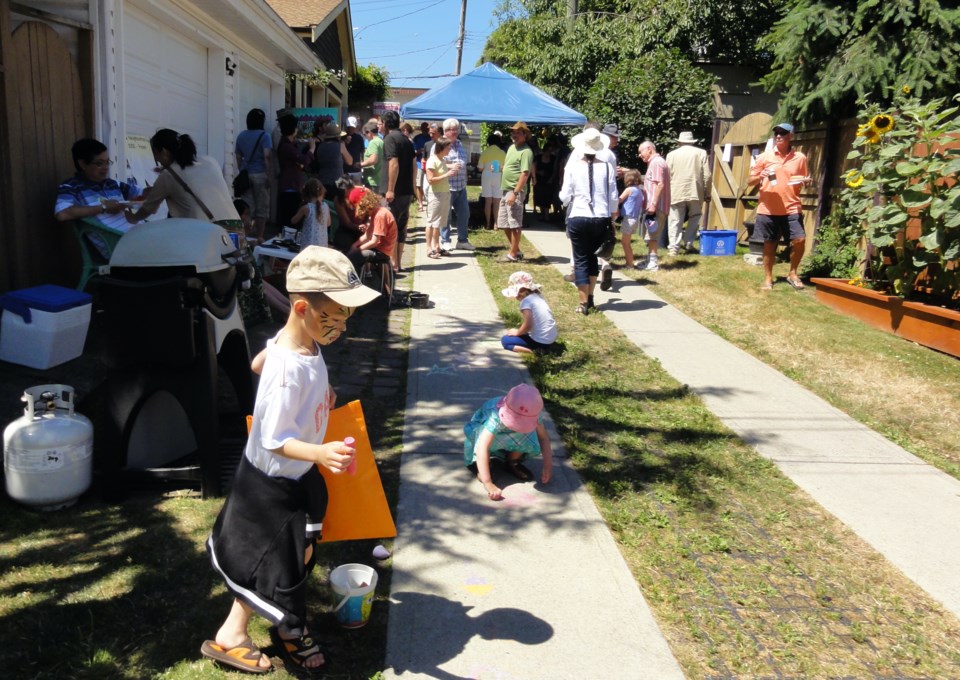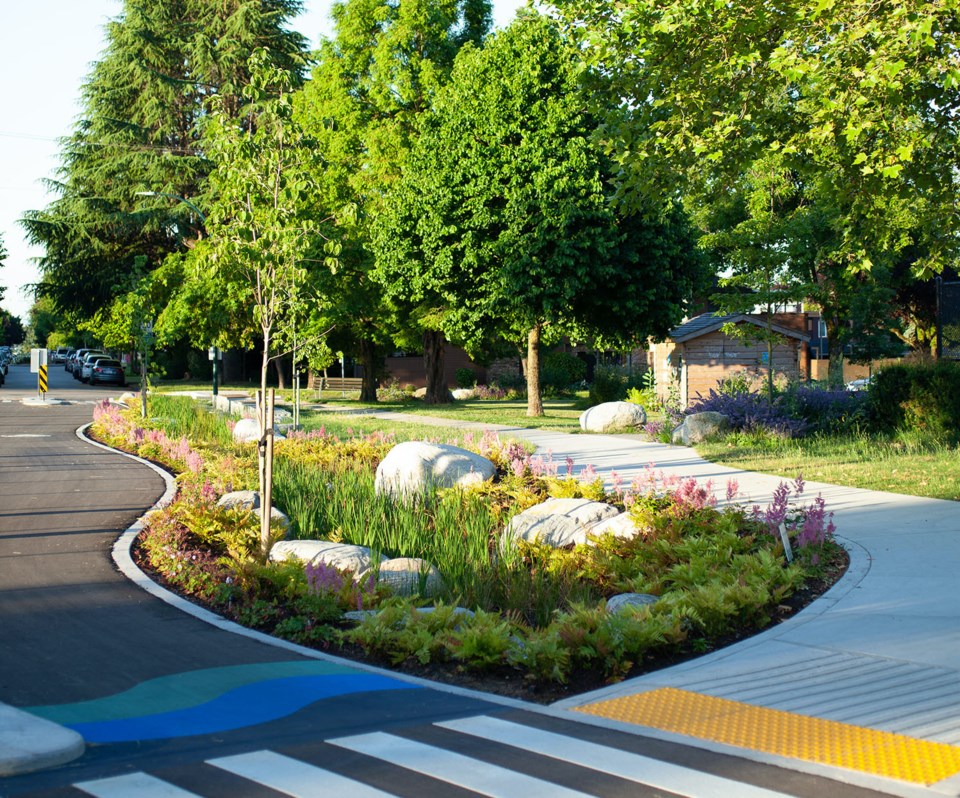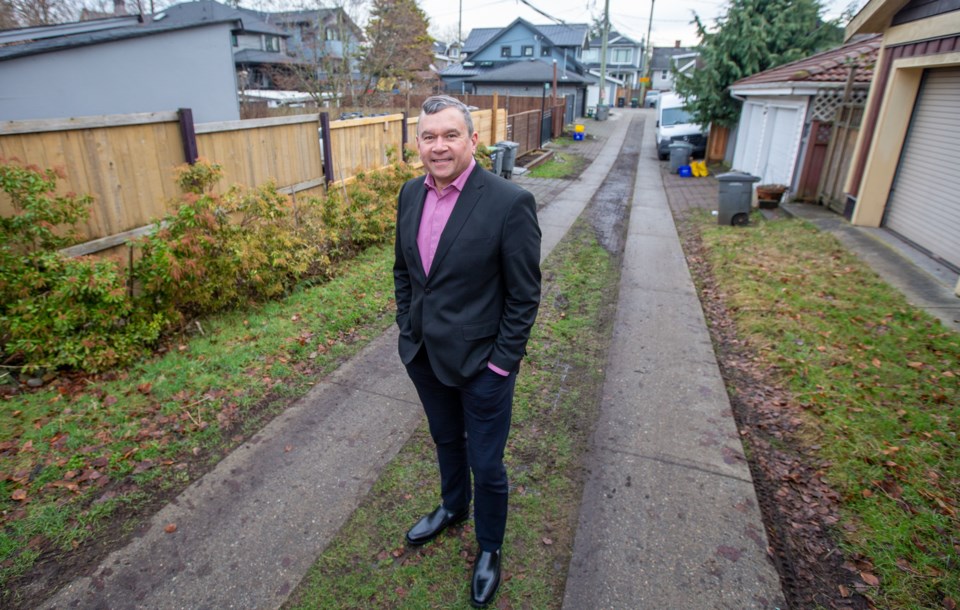A day after a rainfall in February is not the best time to be visiting the “country lane” that runs behind city councillor Mike Klassen’s house near the intersection of Fraser Street and King Edward Avenue.
Winter has done what it does to grass, muddy patches are here and there.
It’s also garbage day and the lane is lined with trash bins and recycling boxes, reducing the visual appeal of what Klassen has come to enjoy in the 20 years since city crews gave the roughly 200-foot long strip a makeover as part of a demonstration project.
“This looks a lot of different in spring and summer,” says Klassen, scrolling through photos on his phone of lush gardens, green grass and neighbours enjoying a summer get-together.
The lane is one of three in Vancouver that council approved in July 2002 to be redesigned as an experiment in sustainability. The two other lanes are near Maple and 5th Avenue, and south of Yale Street between Kaslo and Slocan streets.
As can be viewed in the photographs for this story, the lanes are set off by two narrow concrete strips that run the length of the lane, making it durable for vehicles to pass by. The area between the strips is covered in grass.
“This innovative design would contribute to a more attractive, greener, rural aesthetic while reducing environmental impacts and discharges to the city’s storm sewer system,” said the staff report from 2002.
“As with any new design, the short and long-term performance of the country lane design will need to be monitored.”

Heat dome
Klassen’s opinion is that the lane has been a success, not only in assisting with run-off from rain and pollutants from vehicles, but created a place for neighbours to socialize and enjoy the labour they put into their gardens.
At a time when the city has created more public spaces such as plazas for people to gather, and staff continues its focus on “place making” and fighting climate change, Klassen believes it makes sense to explore adding more country lanes across the city.
“Especially with the heat dome, and with the changing climate — and including the way that we're seeing patterns of heavy rainfall — this is such an ideal situation,” said Klassen, a longtime Fraser Street-area community advocate who was elected to council in October 2022.
At a council meeting last week, Klassen put his request in writing in the form of an amendment to council’s approval of a framework to help guide the city’s “healthy waters plan,” which is a multi-pronged strategy to upgrade the sewer and drainage systems.
The strategy also calls for the city to increase the retention and infiltration of rainwater into the ground and create more naturalized areas within the rainwater management system, which the city has been doing with initiatives such as rain gardens, stormwater tree trenches, bioswales and a street horticulture program.
Saving money
Alex Boston, a fellow of the Simon Fraser University Morris J. Wosk Centre for Dialogue and executive director of Renewable Cities, is very familiar with the strategy and has visited two of the country lanes.
Boston said he supports Klassen’s push for more lanes largely on the same points the councillor made related to sustainability and creating a place for neighbours to socialize and build community.
Saving the city money in the long term is another reason.
“You wouldn't be resurfacing the lane, so you're saving money on all the asphalt and the paving costs,” he said. “Number two is our stormwater system is exceeding its capacity. And it's really, really expensive to re-size stormwater systems. If we allow much more on-site rain capture, then we don't have to re-size our existing stormwater systems.”
The demonstration project in 2002 had a budget of $150,000, so none of the residents whose properties backed on to the lanes had to pay for the upgrade. Typically, improvements made to a residential lane would have to be shared by residents.
The staff report from 2002 said a lane at the time would cost $100,000 to lay down asphalt, with $65,000 of that paid by residents. Both Boston and Klassen believe another formula could be considered so a country lane project wouldn’t only go to residents who can afford it.
But that formula may never be considered and another country lane never built.
'Mixed success'
Jimmy Zammar, the city’s director of urban watersheds, sewers and drainage, said in an email to Glacier Media that staff found the three lanes to have had “mixed success.”
“Two of the three laneways have deteriorated faster than anticipated, and one laneway has held up very well, and has been stewarded and cherished by nearby residents,” Zammar said.
“Overall, while these country lane projects have potential to bring aesthetic, environmental, and public space benefits to the community, our preliminary assessment has indicated that they are not the most optimal rainwater management solutions when compared with other nature-based solution designs and opportunities around the city.”
Zammar said other designs for lanes are being trialled to better manage rainfall, such as porous asphalt laneways that allow water to drain through the asphalt surface to the soils below.
He cited successful examples of permeable pavement used in lanes and streets in Olympic Village. He also pointed to the bioswales at Woodland Drive and Second Avenue, Prince Edward Street in Sunset Park, and 63rd Avenue and Yukon Street.

$41 million in new green rainwater infrastructure
Since 2002, he said, the city has built 319 green rainwater infrastructure projects that combined intercept 210 million litres of rainwater on average per year.
“These projects help to reduce urban heat island, improve biodiversity, increase green space, while providing public space improvements and community benefits,” said Zammar, noting the 2023-2026 capital plan recently approved by council includes $41 million in new green rainwater infrastructure assets “that aim to capture rainwater closer to where it falls, mitigate flood risk and climate change impacts, preserve capacity in the sewer pipe system, while providing environmental, community and public space benefits.”
Still, Klassen believes there’s more room for country lanes.
“One of the things I hope to do is provide perspectives to staff from me and others in the area with experience with this space,” said Klassen in an email after learning of Zammar’s response to Glacier Media’s questions about country lanes.
“I've lived beside it for two decades and I've yet to have a chance to speak to city staff about it, nor has anyone else here to my knowledge.”
'A modern country lane'
Boston had a similar reaction to Zammar’s response.
“There is great value in councillor Klassen's motion and an opportunity to explore a deeper examination of the value of better utilizing the immense network of lanes that are a sizable share of the city's real estate assets to deliver better value for Vancouver residents and businesses,” Boston said in a follow-up email.
He said cities know a lot more about green infrastructure today than in 2002, so a 2023 version of a country lane could be designed to play a much more effective role in stormwater management.
“Would it look like that old country lane? Probably not,” he said. “It would be part country mouse/part city mouse, a modern country lane! Does that mean those old country lanes were a waste of money. Heck no! We need to experiment. They also inspired this policy discussion.”



